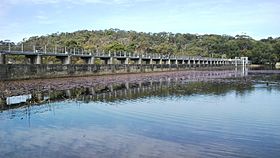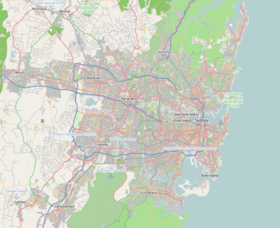Manly Dam facts for kids
Quick facts for kids Manly Dam |
|
|---|---|

Manly Dam wall
|
|
|
Location of the dam in Greater Sydney
|
|
| Coordinates | 33°46′33″S 151°14′52″E / 33.775803°S 151.247769°E |
| Purpose | Multi-purpose:
|
| Status | Decommissioned |
| Opening date | 1892 |
| Owner(s) | Sydney Water |
| Dam and spillways | |
| Type of dam | Gravity dam |
| Impounds | Curl Curl Creek |
| Height (foundation) | 20 m (66 ft) |
| Length | 250 m (820 ft) |
| Dam volume | 8×103 m3 (280×103 cu ft) |
| Spillway type | Uncontrolled |
| Spillway capacity | 400 m3/s (14,000 cu ft/s) |
| Reservoir | |
| Total capacity | 2,000 ML (441×106 imp gal) |
| Catchment area | 5.52 km2 (2.13 sq mi) |
| Surface area | 30 hectares (74 acres) |
| Normal elevation | 35 metres (115 ft) AHD |
| Official name | Manly Dam |
| Type | State heritage (complex / group) |
| Designated | 18 November 1999 |
| Reference no. | 1327 |
| Type | Water Supply Reservoir/ Dam |
| Category | Utilities - Water |
| Builders | Public Works Department |
The Manly Dam is a special old dam located near King Street, Manly Vale. The large lake behind it, called a reservoir, stretches into Allambie Heights. Both areas are part of the Northern Beaches Council in New South Wales, Australia. The reservoir is found within the beautiful Manly Dam Reserve.
The NSW Department of Public Works designed and built the dam in 1892. Today, the reservoir and dam are owned by Sydney Water, a government group in New South Wales. Manly Dam was officially added to the New South Wales State Heritage Register on 18 November 1999, meaning it's an important historical site.
Contents
History of Manly Dam
Manly Dam was built in 1892 by the NSW Department of Public Works. Its main job was to provide drinking water for the Manly area. Over time, it also supplied water to nearby suburbs like Balgowlah and Seaforth. Eventually, it served the entire coastal strip of the former Warringah area, reaching as far north as Mona Vale.
How the Dam Was Built
This dam is a type called a gravity dam. It's made of a huge amount of concrete. The dam wall is about 19 meters (62 feet) tall and 250 meters (820 feet) long. The area that collects rainwater for the dam, called its catchment area, covers about 520 hectares (1,285 acres). This area extends all the way to Frenchs Forest.
The NSW Department of Public Works built the dam for the local council. This was part of a complete water system for Manly. It included the dam, a pumping station, pipes, a service reservoir, and a network to deliver water. The local council ran it for ten years. Then, in 1902, the Metropolitan Water Sewerage and Drainage Board took over. They paid the original cost of A£37,820, minus what the council had already paid.
Increasing Water Storage
The concrete dam was first designed to hold a lot of water. In 1909, it was improved by making the spillway (where excess water flows out) larger. This allowed the water level to be raised, increasing the dam's storage capacity. The capacity was boosted even more in 1914 and again in 1922. By 1922, the dam could hold about 441 megalitres (116 million US gallons) of water.
In 1920, a water filtration plant was added. This plant helped clean the water using settling basins and sand filters. However, by 1928, the demand for water grew too much for the dam to handle. So, in 1929, Manly and Warringah started getting their water from a pipeline connected to Sydney's main water system. By 1936, the dam's pumps were removed.
Dam's Later Use
Even though it was mostly phased out, Manly Dam was used again during a long drought from 1934 to 1942. Pumps were brought in, and a large amount of water was taken from the dam to help Sydney's supply.
After 1942, parts of the old water treatment plant were used for experiments. Different government departments and even the University of New South Wales set up laboratories there. They studied how water moves and behaves. These facilities are still used today for research.
From 1979 to 1981, the dam wall was made stronger to meet modern safety standards. Engineers used a new method: they sank long steel rods deep into the rock foundations. This technique was very new at the time and was recognized worldwide.
What Manly Dam Looks Like
Manly Dam is a large concrete wall that holds back the Curl Curl Creek. It's about 19 to 20 meters (62 to 66 feet) tall and 250 meters (820 feet) long. The dam is located about 3 kilometers (1.9 miles) northwest of Manly. The area that feeds water into the dam, the catchment, is about 520 hectares (1,285 acres) and reaches to Frenchs Forest.
Today, the dam's catchment area and the stored water are mainly used for fun activities like picnicking and bushwalking. The water is also used by the research laboratories of Sydney Water, the Public Works Department, and the University of New South Wales.
The dam wall and its features are in good condition. The strengthening work done between 1979 and 1981 used a method called post-tensioning. This involved anchoring vertical steel rods into the rock foundations and the top of the dam.
Why Manly Dam is Important
Manly Dam is considered a significant heritage site for several reasons. It's a great example of a medium-sized concrete gravity dam from the late 1800s.
Historical Importance
The dam is historically important because it shows how Sydney's water supply developed. It was an independent water system, built even after a major water scheme for Sydney was already in place. It's a rare reminder of a time when Sydney's northern beaches were quite separate from the main city. The dam was designed by important engineers from the NSW Department of Public Works. It also shows how local councils were allowed to borrow money for water projects in the early 1890s.
Design and Technical Achievements
Manly Dam is a simple and attractive structure located in a pretty setting. It's a good example of a basic concrete gravity dam. It looks impressive with its relatively thin wall standing between the reservoir on one side and the valley on the other.
The dam is also technically important. It's still used by hydraulics laboratories for experiments. Plus, it was the site where a new method for strengthening dam walls was first used. This technology was a world-first and is now a common way to make dams safer.
Community Value
The public, including the National Trust of Australia (NSW), highly values Manly Dam. It's listed on the National Trust Register, showing its importance to the community.
Research Potential
Because Manly Dam is an old concrete gravity dam that isn't used for water supply anymore, it's perfect for research. It helps scientists and engineers learn about water movement and test new ways to strengthen dams.
Unique Features
Manly Dam is the largest and most developed of the independent water supply systems that still exist in the Sydney area. It's also one of the very few large dam structures located right within Sydney's suburbs. The dam's strengthening project pioneered a world-first technology, which makes it even more unique.


